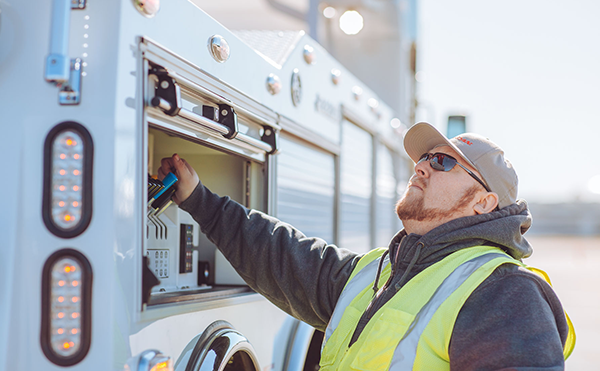
Brian J Riker
President and Chief Compliance Specialist,
Fleet Compliance Solutions, LLC
A version of this column originally appeared
in the Sept 10, 2021 Issue of American Towman
Modern tow trucks and car carriers are very complex machines that, although greatly improved from years past, still require regular maintenance to stay operational and safe. A large part of this maintenance also contributes to your overall Safety Management System (SMS/CSA) score.
Keep in mind, although towing is very different from trucking in many aspects it is still viewed by the regulators and insurance companies as part of the overall trucking industry, which means your personal and company’s SMS score is very important. A poor SMS score can result in significant insurance premium increases, possibly even a refusal to renew, or make an individual driver unemployable.

SMS score, the BASICs, and why they are important
BASIC is an acronym for Behavior Analysis and Safety Improvement Categories. This is part of their Compliance, Safety and Accountability Program (CSA) that monitors individual drivers and the motor carriers they work for to determine who is generally safe and who needs some coaching, or as the Federal Motor Carrier Safety Administration (FMCSA) likes to call it, intervention. I can assure you that the last thing you want is for FMCSA to intervene in how you operate your company!
In most states, a towing company is required to have a valid US DOT number, even if they only operate intrastate, for tracking and data collection purposes. This is how all your inspections and other roadside motor carrier enforcement interactions are tracked, ranked, and reported for analysis and intervention when necessary. Every infraction has a point value, the more serious the violation the higher the points. These violations remain on your record for up to three years, losing value each year. These points also contribute to an Inspection Selection Score (ISS) which is used by the automated systems for weigh station bypass and by the officers watching traffic as it passes to decide who gets selected for an inspection when no obvious defects are visible. The lower the score the less likely you are to be selected for an inspection.
Your insurance company also monitors this score, using it to rate your policy for risk when the driving records and loss runs are inconclusive. They also use it to verify that the information reported to them by you is accurate. I have witnessed insurance carriers cancel policies for fraud when the tower reported they stay within a small radius of their base (usually for significant premium reductions) but there are several inspections reported hundreds of miles outside this radius. Insurance companies can also catch unreported drivers and equipment using this data, and other data from a product called the CAB Report. Bottom line, your roadside performance and SMS/CSA scores are critical to operational success.
What does the inspector look for?
In North America commercial vehicle inspectors and their respective agencies participate in the Commercial Vehicle Safety Alliance (CVSA), which is intended to provide uniform training and enforcement of the Federal Motor Carrier Safety Regulations. The US DOT, through FMCSA, is charged with enforcing these regulations but they do not have the staff or authority to be everywhere, so they partner with State and local law enforcement agencies to conduct routine inspections, investigations, and audits.
Inspections in North America are broken down into eight levels, although not all levels apply to the average tower. Most often a tower will undergo either a level 1, 2, or 3 inspection. Level 1 is the most detailed in which they check credentials, and physically inspect the vehicle(s), including undercarriage and brake adjustments, and cargo. This inspection typically takes 45 to 60 minutes to complete. Level 2 is a quick walk-around of the vehicle, driver paperwork, and cargo securement. Level 3 is the easiest as it is only a driver and vehicle credential check.
The most common violations cited for tow trucks and car carriers include inoperable/missing lights, an unsecured or improperly secured load and a driver not having a medical certification. Not using a proper tie-down on the deck is most often cited, including using damaged or unmarked straps or chains.
Many violations are avoidable
If the strap or chain has any damage or the ratings can’t clearly be determined, take it out of service. Secondary attachment (safety chains) on towed vehicles runs a close second. Other problems are failure to properly secure a vehicle to the wheel lift, under lift, or tow bar. Use your straps or chains as intended by the towing equipment manufacturer and be sure they are tight and properly installed. Even if it was an extra piece and not required by regulation, if it comes loose or is damaged the officer is within their rights to note the violation on the inspection report.
These violations are easily preventable with just a little effort, especially the medical certification. Drivers should note that regardless of your state laws or exemptions, Federal regulations require a medical certification to operate any vehicle with a gross weight rating in excess of 10,000 pounds and used in interstate commerce. Just get the medical card and carry it with you. As a tower, you often are engaging in interstate commerce without realizing it. This is a case of better safe than sorry because not being qualified is an out-of-service violation (the highest point level) and will require that another qualified driver be sent to remove your truck from the inspection site.
Some of the tougher-to-catch violations that are common include brakes out of adjustment, inner wheel seal leaks, and other underbody mechanical defects. Enforcement is particularly harsh on rubbing or chaffed brake lines, so make sure you have spacers or other means to keep the lines or hoses from rubbing together.
A good preventative maintenance program will include thoroughly cleaning the underside of the vehicle and conducting a complete DOT equivalent inspection every 90 days. This is also a great time to check wrecker or carrier body mounts, subframes, and other critical components that don’t get inspected daily.
More violations that are easy to prevent, but easy to forget
Window tint and lettering are other violations that pop up often. Under Federal regulations, window tint on the windshield and front two windows typically is not allowed. I say it that way because modern factory tint on these windows is just about at the legal limit of 30%. FMCSA requires that 70% of light pass through these windows. The other windows may be tinted as dark as your state law allows as there is no Federal limit. There is a process for a medical waiver, however, unless it is truly necessary, I advise against it as the tinted windows give the inspector a reason to pull you over and conduct an inspection.
As for lettering, the most common vehicle marking violation is not displaying a US DOT number, or not having it visible. Regulations require it be in a sharply contrasting color, legible from 50 feet away in normal daylight, in at least two-inch high letters and it must include “US DOT” before the number.
They also require the legal business name, as listed in their database, to be displayed clearly on the vehicle with the words “operated by” preceding it if any other trade name is on the vehicle. Cry fonts, shadow lettering, and such may look cool, but they likely are not compliant and can be just another reason your truck may be selected for an inspection.